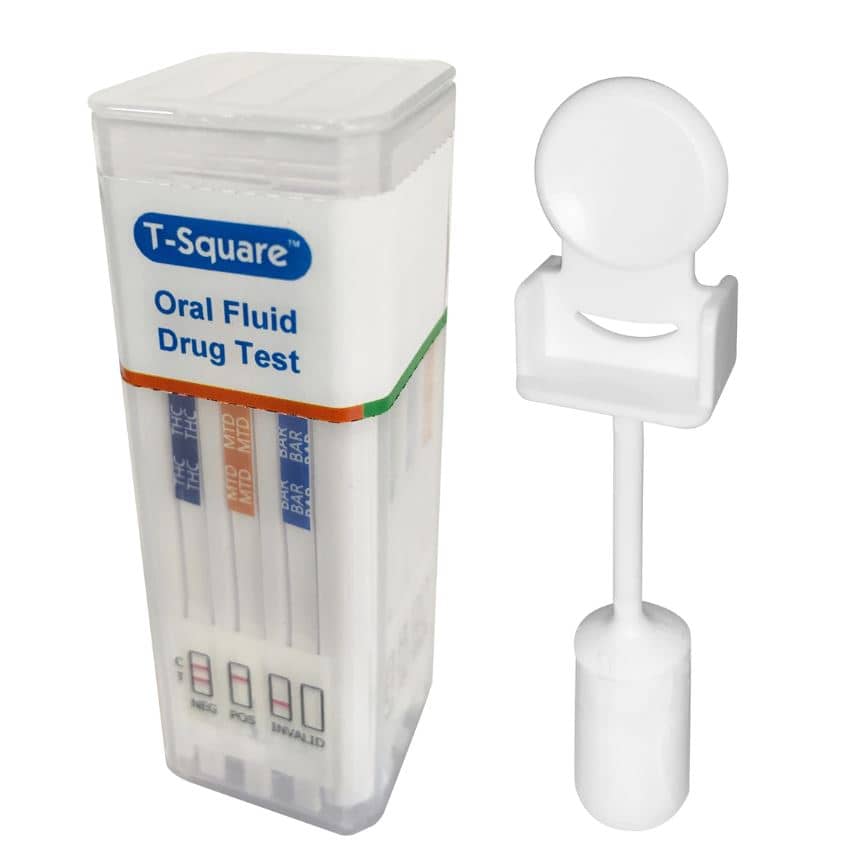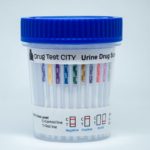
A 10 panel drug test looks for ten distinct substances, each selected to provide a holistic overview of an individual’s drug usage. From commonly abused substances such as marijuana and cocaine to prescription medications like opioids and benzodiazepines, this comprehensive panel covers a wide spectrum of drugs.
By analyzing these substances, professionals can gain invaluable insights into an individual’s overall drug use, facilitating appropriate interventions and treatment plans when necessary.
Our 10 Panel Saliva Drug Test tests for:
- (THC) Marijuana
- (COC) Cocaine
- (OPI) Opiates
- (AMP) Amphetamine
- (MET) Methamphetamine
- (BAR) Barbiturates
- (MDMA) Ecstasy
- (MTD) Methadone
- (OXY) Oxycodone
- (PCP) PCP
The Testing Procedures for 10 Panel Drug Tests
While the concept of drug testing may seem straightforward, the 10 Panel Drug Test follows a meticulous process to ensure accuracy and reliability. From sample collection to handling and analysis, each step is carefully executed to minimize errors and false results. By adhering to strict guidelines, professionals can confidently interpret the test outcomes and make informed decisions based on the results obtained.
For a 10 Panel Saliva Test, the agent would follow these steps:
Step 1: Remove the test cube and the sponge collector from the foil pouch by tearing at the notch. Place the test cube upright on a level surface
Step 2: Put the sponge end of the collector on your tongue to collect oral fluid for about 7 minutes or 3 minutes if using the saturation indicator, until the color on saturation indicator strip appears RED in the indicator window.
Step 3: Open the test cube and place the fully saturated sponge collector inside the test cube. Press the sponge collector down firmly until it reaches the bottom of the test cube, then close the cube lid tightly while compressing the collector. Keep test cube upright on a flat surface and follow Step 4.
Note: Make sure the sponge collector is inserted vertically and the handle of collector is put into the clamp.
Step 4: Read results at 5 minutes. Do not read after 5 minutes. A negative result will be shown by two color lines on the strip. The intensity of the lines do not matter. A positive result will be shown by a single color line in the C section, and no color lines present in the T section. A single color line in the T section means that the results are invalid and the test should be repeated.
How Far Back Does a 10 Panel Urine Test Go?
A 10 panel urine test goes back approximately 7-14 days. Benzodiazepines have the longest detection time of drugs on a 10 panel drug test. You can check common detection times to see how long a urine screen goes back on each drug of abuse.
From short windows for substances like cocaine to longer ones for cannabis, knowledge of detection windows aids in assessing recent drug usage and monitoring individuals in recovery programs.
Reliability and Accuracy Matters
Accuracy and Reliability: Accurate and reliable drug test results are paramount in maintaining trust and integrity within the testing process. While the 10 Panel Drug Test boasts impressive accuracy rates, it is essential to acknowledge the factors that can influence the reliability of these tests. Variables such as sample handling, equipment calibration, and professional expertise play a crucial role in ensuring accurate results. By addressing these factors, professionals can enhance the reliability of drug testing outcomes.
10 Panel Drug Test Applications Across Industries
Drug testing plays a pivotal role in ensuring safety, productivity, and compliance across various industries. The applications of 10 Panel Drug Tests are vast and diverse, making them a valuable tool in maintaining drug-free environments. Let’s explore how different sectors utilize this comprehensive screening method to safeguard their workforce and uphold industry standards.
In the transportation industry, such as aviation, trucking, and public transportation, safety is paramount. Implementing 10 Panel Drug Tests helps ensure that employees operating vehicles or working in safety-sensitive positions are free from the influence of drugs. By conducting regular drug tests, transportation companies can reduce the risk of accidents, enhance public trust, and adhere to regulatory requirements.
Healthcare institutions also heavily rely on 10 Panel Drug Tests to protect patient safety and maintain the integrity of medical services. Doctors, nurses, and other healthcare professionals are entrusted with the well-being of patients, and any impairment caused by substance abuse can have severe consequences. By incorporating regular drug testing protocols, healthcare organizations can identify potential risks, intervene when necessary, and provide a safe environment for both patients and medical professionals.
The manufacturing industry also recognizes the importance of a drug-free workplace. Whether it involves operating heavy machinery or handling hazardous materials, maintaining a drug-free environment is crucial for the safety of employees and the quality of production. By implementing 10 Panel Drug Tests, manufacturing companies can ensure a sober workforce, minimize the risk of accidents, enhance productivity, and meet industry regulations.
Legal and Ethical Considerations
Legal and Ethical Considerations: As with any procedure that involves personal information, the 10 Panel Drug Test raises important legal and ethical considerations. Balancing privacy rights, consent, and potential consequences requires thoughtful navigation within the realms of legality and ethics. By adhering to established regulations, professionals can perform drug testing while
Advantages and Limitations of 10 Panel Drug Tests
While the 10 Panel Drug Test offers numerous advantages in comprehensive drug screening, it is important to acknowledge its limitations.
A 10 panel drug test is slightly cheaper than a 12 panel drug test, but in most cases the cost savings doesn’t exceed the value of having two extra strips.
10 panel drug tests will sometimes lack specific drugs the user needs for testing. Also, oral drug tests are not yet CLIA waived and can only be used for forensic use.
Exploring Alternatives
In addition to the 10 Panel Drug Test, various alternative drug testing methods are available. These alternatives may include different panel configurations or specialized tests for specific substances.
2 popular alternatives are:
Conclusion
In conclusion, the 10 Panel Drug Test stands as a powerful tool in combating substance abuse and promoting a drug-free future. From its comprehensive panel of substances to its strict testing procedures, this screening method provides valuable insights into an individual’s drug usage history. By understanding its components, applications, and limitations, professionals can utilize the 10 Panel Drug Test effectively in diverse industries and settings.
As technology continues to advance and our understanding of substance abuse deepens, the future holds exciting possibilities for even more accurate, efficient, and comprehensive drug testing methods. Together, we can work towards a society where drug-free environments flourish, safeguarding the well-being of individuals and communities alike.

